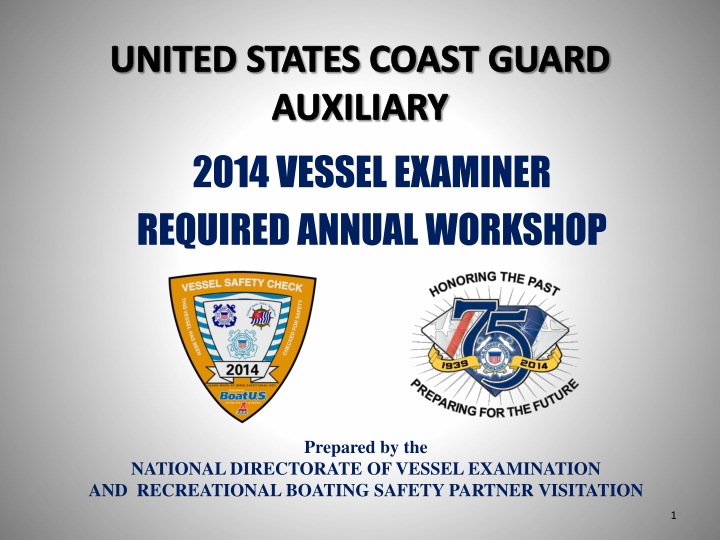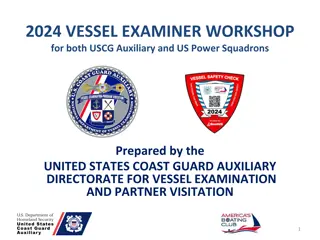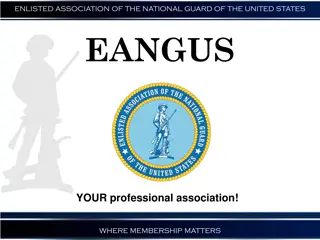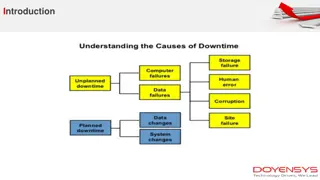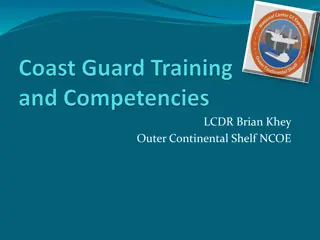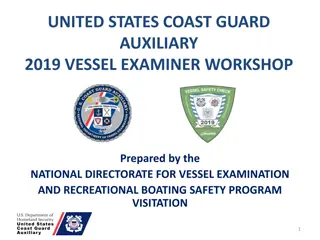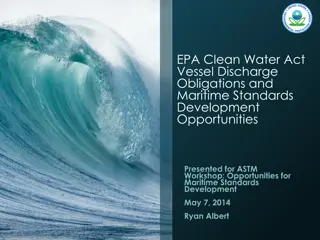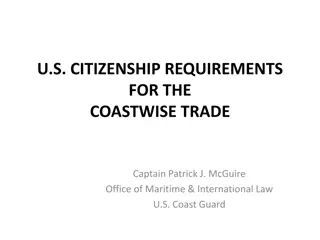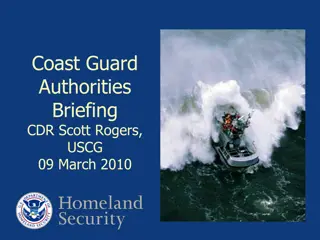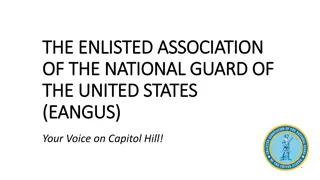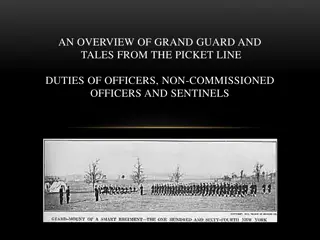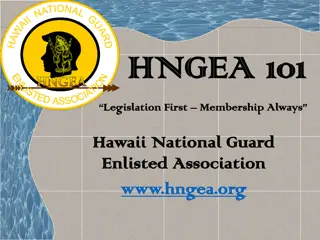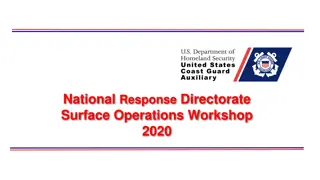United States Coast Guard Auxiliary 2014 Vessel Examiner Workshop
The United States Coast Guard Auxiliary's 2014 Vessel Examiner Workshop focuses on educating Vessel Examiners to enhance boating safety and ensure compliance with safety regulations. The workshop covers VSC procedures, conducting safety checks, and operational facilities for paddle crafts. It includes quizzes to reinforce learning. Vessel Examiners play a crucial role in promoting safe recreational boating practices and preventing accidents.
Download Presentation

Please find below an Image/Link to download the presentation.
The content on the website is provided AS IS for your information and personal use only. It may not be sold, licensed, or shared on other websites without obtaining consent from the author.If you encounter any issues during the download, it is possible that the publisher has removed the file from their server.
You are allowed to download the files provided on this website for personal or commercial use, subject to the condition that they are used lawfully. All files are the property of their respective owners.
The content on the website is provided AS IS for your information and personal use only. It may not be sold, licensed, or shared on other websites without obtaining consent from the author.
E N D
Presentation Transcript
UNITED STATES COAST GUARD AUXILIARY 2014 VESSEL EXAMINER REQUIRED ANNUAL WORKSHOP Prepared by the NATIONAL DIRECTORATE OF VESSEL EXAMINATION AND RECREATIONAL BOATING SAFETY PARTNER VISITATION 1
2014 VE WORKSHOP As a Vessel Examiner you play an important role in helping keep our waterways a safe place for the recreational boater. Your dedication in helping educate the recreational boater in boating safety and ensuring they carry and know how to use the required equipment aboard their vessel is an important responsibility and should not be taken lightly! We appreciate your time and dedication to BOATING SAFETY 2
Workshop Objectives This workshop is designed as a refresher for Vessel Examiners, to review current and new requirements, and provide practical and relevant knowledge to assist in serving the boating public 3
Workshop Contents The workshop consists of four sections: VSC Process and Procedures Conducting the Vessel Safety Check Paddle Craft Operational Facilities At the end of each section there is a brief quiz with answers based on the material presented The quiz can be answered as a group and will serve to reinforce the material covered in each section 4
The VSC Program The Vessel Safety Check (VSC) program helps to achieve voluntary compliance with federal and state recreational boating safety laws regarding the carriage of safety equipment It raises boater s awareness of safety issues through one-on-one contact by volunteer Vessel Examiners It is intended to serve as a prevention through education, outreach, and volunteer compliance activity 6
Where Can We Perform Vessel Safety Checks? VEs may perform VSCs on boats anywhere in the 50 states and six territories of the United States You should contact the nearest Auxiliary or Power Squadrons to familiarize yourself with local or state rules and regulations, and to coordinate your efforts with those of the District in which you are visiting 7
Maintaining Certification To remain certified, a VE must complete at least five VSCs each calendar year If any VE fails to perform the annual certification procedures within the last five years, they must complete two satisfactory VSCs under the supervision of a certified VE in order to regain their certification, and then complete at least five VSCs for that calendar year If a VE fails to perform the annual certification procedures for five consecutive years, that member will have to meet the full initial qualification criteria to regain qualification 8
Assignment to Duty FC/VFC/FSO-VE Notification: Before going out to do a VSC, be sure to let your FC, VFC, or FSO-VE know by phone, email, or other means This is important to satisfy the assignment to duty requirement in the event of an accident, injury, or damage 9
Uniforms Although not required, the VE should make every attempt to wear a proper uniform when conducting a VSC Check what uniform is approved in your area Don t refuse to conduct a VSC if you are asked and in civilian attire 10
VSC Courtesy As a courtesy to the vessel owner, ask permission to come aboard; say: Permission to come aboard? Be cautious that nothing you are carrying or wearing can cause damage to the vessel you are examining If you have an appointment be on time. If for any reason you have to cancel, contact boater as soon as possible 11
Pre-Examination Working with the boat owner in advance provides: More exposure to the boater More opportunity to discuss boating safety More opportunity to solicit interest in the Auxiliary 12
Bottom Line For more information, encourage the boat owner to visit: http://www.safetyseal.net The bottom line is to do what it takes to create safe boats and safe boaters 13
Supervised Vessel Safety Checks Any VE performing supervised vessel safety checks (VSC), whether in conjunction with Initial Qualification or Recertification, must perform the supervised VSC on power/sailing vessels only, no paddle crafts Documented on Form 7012 and NOT Form 7012A (Paddle Craft VSC) Report activity on ANSC 7038 per policy Once member is certified, paddle craft VSCs may be performed 14
The VSC Decal Display of the VSC decal indicates that, at the time of the safety check, the boat carried the proper safety equipment It does NOT imply that the boater may not be stopped and checked by law enforcement 15
Awarding the VSC Decal Only current year VSC decal should be displayed Old decals should be removed; however, VE/Owner may place new decal directly over old VSC decal VSC decal must be affixed immediately after examination by the VE or by the operator in the presence of the VE Affix in a location not to interfere with or obscure the operator s view 16
VSC Decal Placement On the lower forward corner of a portside window If no window is available, to the dashboard or the back of a seat Decals should only be affixed to permanently installed equipment 17
Quiz [1] If an owner or operator has consented to a VE performing a VSC on his/her vessel, what can be expected? [a] A one-on-one education about boating laws, safety equipment and operation of a vessel in a safe manner [b] A guarantee against a boarding by the Coast Guard or local/state marine authorities, as long as the VSC decal is current [c] A minimum of a 10% discount on the boat owner's marine insurance policy [d] A free survey of the boat, saving the owner a substantial amount of money by not having to hire a marine surveyor 18
Answer [1] If an owner or operator has consented to a VE performing a VSC on his/her vessel, what can be expected? [a] A one-on-one education about boating laws, safety equipment and operation of a vessel in a safe manner 19
Quiz [2] Because of unusual circumstances, you were unable to conduct five VSCs last year. What happens now? [a] You have to meet the full initial qualification criteria to regain your qualifications [b] You have to do ten this year to keep your qualifications and to make up for last year [c] You have to do at least two VSCs under supervision of a certified VE to regain your qualifications and then five for this year [d] You can't regain your qualifications. Once you miss a year you're too rusty to be an effective VE 20
Answer [2] Because of unusual circumstances, you were unable to conduct five VSCs last year. What happens now? [c] You have to do at least two VSCs under supervision of a certified VE to regain your certification and then five for this year 21
Quiz [3] A vessel owner consents to a VSC on a vessel that has a prior year s decal on it. The vessel passes and is eligible for a decal. What should you do? [a] Since only one VSC decal is permitted to be displayed at any time, have the owner remove the old decal and apply the new one [b] Save the new decal for your next VSC and just give the owner the Form 7012 or 7012A [c] Place the new decal next to the old one. Owners like to display decals for all the years they've been examined [d] Place the new decal on the starboard window so that it will not interfere with or obscure the operator's view 22
Answer [3] A vessel owner consents to a VSC on a vessel that has a prior year s decal on it. The vessel passes and is eligible for a decal. What should you do? [a] Since only one VSC decal is permitted to be displayed at any time, have the owner remove the old decal and apply the new one 23
Quiz [4] You are on vacation in another state that's part of a different district. Should you bring your VSC materials with you? [a] No, don't bother. You won't get credit outside your district [b] No, don't bother. The decals are numbered and allocated for only your specific district. [c] Yes, but you can only examine vessels that are registered in your home district. Therefore, make sure you look for those with registration letters representing your state [d] Yes, a qualified Vessel Examiner may conduct a VSC in any state or territory of the United States 24
Answer [4] You are on vacation in another state that's part of a different district. Should you bring your VSC materials with you? [d] Yes, a qualified Vessel Examiner may conduct a VSC in any state or territory of the United States 25
Quiz [5] You happen to be visiting a friend at a local marina. You're wearing casual civilian clothes. A boat owner sees you and asks if you would perform a safety check on the boat. What should you do? [a] Apologize to the owner and explain that you can't do a VSC if you're not in proper uniform [b] Even when you're not in uniform or prescribed dress, a VE should not delay or refuse a request for a VSC [c] Explain that you're off-duty and entitled to some "down time" too. Tell the owner to catch you another time [d] Since activity only counts if you're in uniform, don't waste your time or the boat owner's time 26
Answer [5] You happen to be visiting a friend at a local marina. You're wearing casual civilian clothes. A boat owner sees you and asks if you would perform a safety check on the boat. What should you do? [b] Even when you're not in uniform or prescribed dress, a VE should not delay or refuse a request for a VSC 27
Quiz [6] You have just completed a VSC on a vessel that passes and is eligible for a decal. However, the vessel does not have a windshield. What do you do now? [a] Place the new decal on the dashboard or back of a seat; someplace that will be readily visible [b] Give the owner or operator the decal and let them decide where they would like it [c] Since you may only place a decal on the window or windshield, you never should have done a VSC on this boat in the first place [d] Save the new decal for your next VSC and just give the owner the Form 7012 indicating their boat earned a decal 28
Answer [6] You have just completed a VSC on a vessel that passes and is eligible for a decal. However, the vessel does not have a windshield. What do you do now? [a] Place the new decal on the dashboard or back of a seat; someplace that will be readily visible 29
Conducting the Vessel Safety Check 30
Registration Numbers Here is where many of us begin the Vessel Safety Check and where a large number of boats fail to meet federal requirements Numbers must be properly spaced, in PLAIN BLOCK CHARACTERS of not less than three inches in height, and in contrast to the color of the vessel 31
Registration Numbers Permanently attached to each side of the forward half of the vessel Example of correct format: NJ 1234 AB or NH-5678-AB NOTE: Spaces or hyphens between letter and number groupings must be equal to the width of a letter other than I or a number other than 1 32
Documented Vessel Every documented vessel must have: - An official number - Marked by any PERMANENT METHOD - Cannot be obliterated or obscured Must have the official number permanently affixed in block type Arabic numerals preceded with the letters NO. - Not less than 3 inches in height - On some clearly visible interior integral structural part of the vessel 33
Documented Vessel A documented vessel hull display must: - Have the name and hailing port of the vessel together in one place on the hull (usually on the stern) - Be in letters not less than 4 inches in height - Be clearly readable 34
Life Jackets Boaters must carry one wearable life jacket for each person aboard Life jackets must be: - Coast Guard approved - In good and serviceable condition - Appropriate size for the intended user - Be readily available (i.e. not in locked compartment or manufacturer s plastic bag) Additionally - All vessels 16 feet or over (except canoes and kayaks) must also carry one throwable type life saving device - Throwable devices must be immediately available for use 35
Life Jackets The life jacket label is the best reference to determine if it is the appropriate size, type, and whether it must be worn to count USCG approved inflatable devices: - Authorized for use by persons 16 years of age or older - Require regular maintenance - Must have a full cylinder and all status indicators green 36
Visual Distress Signals When considering VDS requirements, the applicable term is coastal waters Coastal waters include: - The Great Lakes (excluding Lake St. Clair) - The territorial seas - And those waters connected directly, up to the first point where a body of water is less than two miles wide When conducting a VSC on any waters identified as Coastal (see above), ensure the Area of Operation on Form 7012 is marked as Coastal 37
Visual Distress Signals Visual Distress Signals (VDS) are specifically defined in the Code of Federal Regulations and include only USCG approved devices limited to: - Pyrotechnics - Approved orange flag with black square/circle (day signal only) - Approved electric distress light flashing SOS (night signal only) All VDS need an approval number displayed and the pyrotechnics must not be beyond the listed expiration date 38
Visual Distress Signals The following vessels are not required to carry day signals, but must carry night signals when operating from sunset to sunrise: - Recreational vessels less than 16 feet - Vessels participating in organized events - Open sail boats less than 26 feet and not equipped with propulsion machinery - Manually propelled vessels 39
Fire Extinguishers A fire extinguisher does not have to be mounted to meet federal minimum legal requirements or receive a VSC decal, unless there is a state requirement to the contrary Contrary to prior guidance, there is never an occasion where it is permissible to shake or smack a fire extinguisher. This could lead to compaction of material in the discharge tube 40
Sound Producing Devices Navigation Rules require sound signals to be made under certain circumstances. For the size vessels we examine - ALL we need to remember is: EVERY vessel must carry a horn or an acceptable type whistle audible for mile NONE of the size vessels we examine are now required to carry a bell 41
Navigation Lights Recreational vessels are required to display navigation lights: - Between sunset and sunrise - Periods of reduced visibility Vessels under machine propulsion are considered power-driven vessels Even if the owner/operator does not intend to go out after sunset, they must carry the prescribed lights for their vessel type 42
Pollution Placard All vessels 26 feet and larger with a machinery compartment must display an oily waste Pollution placard Placard must be fixed in a conspicuous place in machinery spaces or at the bilge pump control station 43
MARPOL Trash Placard All vessels 26 feet and larger require a MARPOL placard MARPOL placard must be displayed in a prominent location Examiners should take the opportunity to educate boaters that new requirements are being developed and they will need to comply when available 44
Marine Sanitation Devices All recreational vessels with installed toilet facilities MUST have an operable marine sanitation device (MSD) on board Any capability for overboard discharge must be disabled or secured. Acceptable methods include: - Padlocking overboard discharge valves in the closed position - Closing overboard discharge valves and removing handle - Locking door to space enclosing the toilet (Type I and II only) 45
Navigation Rules The operator of a vessel 12M (39.4 feet) or greater is responsible for having and maintaining a copy of the Navigation Rules on board when operating on U.S. inland waters An electronic copy (cell phone, tablet, laptop, etc.) is acceptable as long as the boater can present the required rules when examined Remember, a complete copy of the rules is not required. Only the Inland rules are required to be carried when shoreward of the line of demarcation 46
Overall Vessel Condition Vessel must be free from fire hazards, in good condition, with bilges reasonably clean and visible hull structure generally sound Battery cables should be securely connected, terminals covered, and battery secured to prevent movement (battery requirements do not apply to boats powered by outboard motors) Automotive parts NOT installed on engine Engine HP does not exceed capacity plate Kill switch operational if installed Decks free of hazards 47
Marine Radios Vessels carrying a marine VHF radio must monitor channel 16 (Calling and Distress channel): - When their radio is turned on - When not transmitting or receiving on another channel Advise boaters with DSC radios the importance of obtaining, registering, installing an MMSI number and interfacing with a GPS 48
Accident Reporting The operator of any recreational boat is required to file a Boating Accident Report if the boat is involved in an accident that results in: - Loss of life - Personal injury which is beyond first aid - Damage to the boat and other property $2,000 or more (amount may vary in some states) - Complete loss of boat 49
Quiz [1] An acceptable method for preventing the inadvertent discharge from an installed toilet is: [a] A Type I, II or III MSD if under 65' [b] A dump valve [c] A Type III MSD to recirculate waste [d] A lock on the head door (Type I and II only) 50
